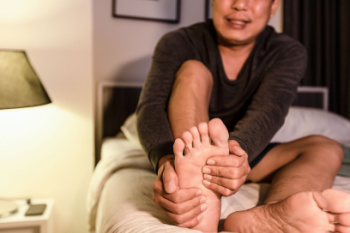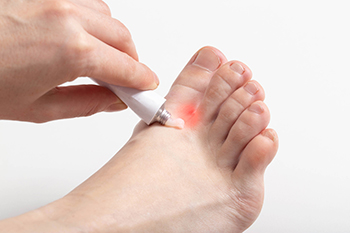
Rheumatoid arthritis is known for causing joint pain and inflammation, but it can also lead to nerve damage. Chronic swelling in the joints may compress nearby nerves, especially in the feet and ankles. This pressure can cause symptoms like tingling, numbness, burning sensations, or shooting pains, similar to peripheral neuropathy. Inflammation from rheumatoid arthritis may also directly damage nerves over time, interfering with how signals travel between your feet and brain. This can lead to changes in balance, walking difficulties, and sensitivity to touch. Treatment focuses on reducing inflammation and protecting joint and nerve health through medications, and wearing supportive footwear. If nerve-related symptoms begin or worsen, it is suggested you see a podiatrist for a thorough evaluation and personalized care plan.
Neuropathy
Neuropathy can be a potentially serious condition, especially if it is left undiagnosed. If you have any concerns that you may be experiencing nerve loss in your feet, consult with Gabrielle Clark, DPM from LA Feet Foot & Ankle Center, Inc. Our doctor will assess your condition and provide you with quality foot and ankle treatment for neuropathy.
What Is Neuropathy?
Neuropathy is a condition that leads to damage to the nerves in the body. Peripheral neuropathy, or neuropathy that affects your peripheral nervous system, usually occurs in the feet. Neuropathy can be triggered by a number of different causes. Such causes include diabetes, infections, cancers, disorders, and toxic substances.
Symptoms of Neuropathy Include:
- Numbness
- Sensation loss
- Prickling and tingling sensations
- Throbbing, freezing, burning pains
- Muscle weakness
Those with diabetes are at serious risk due to being unable to feel an ulcer on their feet. Diabetics usually also suffer from poor blood circulation. This can lead to the wound not healing, infections occurring, and the limb may have to be amputated.
Treatment
To treat neuropathy in the foot, podiatrists will first diagnose the cause of the neuropathy. Figuring out the underlying cause of the neuropathy will allow the podiatrist to prescribe the best treatment, whether it be caused by diabetes, toxic substance exposure, infection, etc. If the nerve has not died, then it’s possible that sensation may be able to return to the foot.
Pain medication may be issued for pain. Electrical nerve stimulation can be used to stimulate nerves. If the neuropathy is caused from pressure on the nerves, then surgery may be necessary.
If you have any questions, please feel free to contact our offices located in New Orleans, and Metairie, LA . We offer the newest diagnostic and treatment technologies for all your foot care needs.

Bunion surgery is a corrective procedure used to realign the bones and soft tissue surrounding the big toe joint when a bunion causes pain or interferes with daily activities. It may be recommended when non-surgical treatments no longer relieve discomfort or when the bunion worsens over time. The procedure involves removing the bony bump and adjusting the affected joint to restore normal alignment. Common reasons to have bunion surgery include chronic pain, swelling, difficulty wearing shoes, and reduced mobility. A podiatrist will evaluate your foot, discuss options, and guide your recovery for the best outcome. If bunion pain affects your quality of life, it is suggested that you consult a podiatrist to see if surgery is the right solution for you.
Foot surgery is sometimes necessary to treat a foot ailment. To learn more, contact Gabrielle Clark, DPM of LA Feet Foot & Ankle Center, Inc. Our doctor will assist you with all of your foot and ankle needs.
When Is Surgery Necessary?
Foot and ankle surgery is generally reserved for cases in which less invasive, conservative procedures have failed to alleviate the problem. Some of the cases in which surgery may be necessary include:
- Removing foot deformities like bunions and bone spurs
- Severe arthritis that has caused bone issues
- Cosmetic reconstruction
What Types of Surgery Are There?
The type of surgery you receive will depend on the nature of the problem you have. Some of the possible surgeries include:
- Bunionectomy for painful bunions
- Surgical fusion for realignment of bones
- Neuropathy decompression surgery to treat nerve damage
Benefits of Surgery
Although surgery is usually a last resort, it can provide more complete pain relief compared to non-surgical methods and may allow you to finally resume full activity.
Surgical techniques have also become increasingly sophisticated. Techniques like endoscopic surgery allow for smaller incisions and faster recovery times.
If you have any questions please feel free to contact our offices located in New Orleans, and Metairie, LA . We offer the newest diagnostic and treatment technologies for all your foot and ankle needs.

Athlete’s foot is a common fungal infection that affects the skin on the feet, often appearing between the toes. It is caused by fungi that thrive in warm, moist environments such as locker rooms, showers, or sweaty footwear. Symptoms include itching, burning, redness, peeling, and cracked skin. Risk factors include wearing tight shoes, poor foot hygiene, and frequenting public places barefoot. A podiatrist can diagnose the condition, recommend antifungal treatments, and offer guidance to prevent recurrence. Proper foot care and early treatment are key to avoiding complications or spreading the infection. If you notice persistent foot irritation or signs of athlete’s foot, it is suggested that you visit a podiatrist for effective care and lasting relief.
Athlete’s Foot
Athlete’s foot is often an uncomfortable condition to experience. Thankfully, podiatrists specialize in treating athlete’s foot and offer the best treatment options. If you have any questions about athlete’s foot, consult with Gabrielle Clark, DPM from LA Feet Foot & Ankle Center, Inc. Our doctor will assess your condition and provide you with quality treatment.
What Is Athlete’s Foot?
Tinea pedis, more commonly known as athlete’s foot, is a non-serious and common fungal infection of the foot. Athlete’s foot is contagious and can be contracted by touching someone who has it or infected surfaces. The most common places contaminated by it are public showers, locker rooms, and swimming pools. Once contracted, it grows on feet that are left inside moist, dark, and warm shoes and socks.
Prevention
The most effective ways to prevent athlete’s foot include:
- Thoroughly washing and drying feet
- Avoid going barefoot in locker rooms and public showers
- Using shower shoes in public showers
- Wearing socks that allow the feet to breathe
- Changing socks and shoes frequently if you sweat a lot
Symptoms
Athlete’s foot initially occurs as a rash between the toes. However, if left undiagnosed, it can spread to the sides and bottom of the feet, toenails, and if touched by hand, the hands themselves. Symptoms include:
- Redness
- Burning
- Itching
- Scaly and peeling skin
Diagnosis and Treatment
Diagnosis is quick and easy. Skin samples will be taken and either viewed under a microscope or sent to a lab for testing. Sometimes, a podiatrist can diagnose it based on simply looking at it. Once confirmed, treatment options include oral and topical antifungal medications.
If you have any questions, please feel free to contact our offices located in New Orleans, and Metairie, LA . We offer the newest diagnostic and treatment technologies for all your foot care needs.

